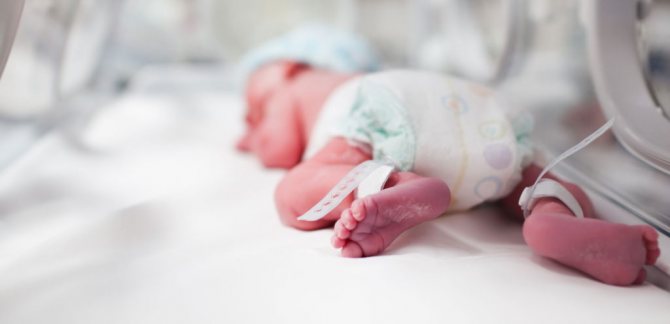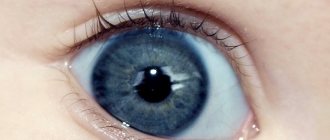Every mother wants her baby to be fine, to feel great and not have any problems. But unfortunately, there are also situations when not everything happens the way we would like it to. There are cases when a baby is born with various pathologies. One of the most dangerous at the moment is asphyxia of the newborn.
Asphyxia of a newborn is a pathology that occurs due to respiratory failure, as a result of which the baby develops hypoxia.
Asphyxia occurs in approximately 4-6% of babies and becomes one of the main causes of perinatal mortality.
The baby develops hypoxia, which poses a danger to the baby’s life. Such babies urgently need resuscitation.
The consequences of asphyxia of a newborn depend on the severity of the baby’s condition, this is determined by the doctor himself.
Types of asphyxia
There are 2 types of newborn asphyxia:
- Primary - it occurs when the baby is in the mother’s womb.
- Secondary - begins within 24 hours after the baby is born.
In terms of severity, this pathology also has varieties: mild, moderate, severe and, most recently, clinical death.
Asphyxia in a newborn fetus occurs due to prolonged intrauterine hypoxia; it has acute and chronic forms.
Develops for the following reasons
- kidney dysfunction;
- lung disease;
- decreased hemoglobin;
- diabetes;
- polyhydramnios;
- pregnancy with two or more fetuses;
- premature aging of the placenta;
- if the mother has bad habits;
- maternal hypertension;
- maternal vegetative-vascular diseases;
- if there were complications during childbirth;
- intrauterine infections, such as: rubella, the presence of chlamydia.
Secondary asphyxia of the newborn usually involves pneumonia or cerebrovascular accident in the infant.
In addition to problems with the baby’s health, it can also cause such problems
- Disease of the cardiovascular system, especially if it is in a period of exacerbation.
- Severe anemia due to lack of iron, especially in the last months of pregnancy.
- Diabetes mellitus, especially in the insulin-dependent form
- If a woman has late toxicosis, which is accompanied by swelling of the legs and high blood pressure.
Also, in frequent cases, asphyxia of newborns occurs if there are any anomalies in labor, improper insertion of the fetal head, a pathologically narrow pelvis of the woman in labor, etc.
We also recommend reading: Temperature in a newborn
Pneumonia is a disease that develops due to incomplete expansion of the lungs. In a newborn, asphyxia occurs due to any problems during pregnancy: abnormalities in the placenta, umbilical cord. Also, if the baby has been without water in the mother’s belly for a long time.
Everyone wants to know what happens in a baby’s body at the time of asphyxia? Despite the fact that asphyxia was caused, the child begins to change processes. How strongly these changes will be visible depends on the time of asphyxia and its intensity.
Apgar score

The most important symptom of asphyxia in a newborn is, first of all, disturbances in breathing, which causes the heart to begin to work poorly and reflexes to decrease. As soon as the baby is born, doctors immediately examine him and evaluate the condition of the newborn on a ten-point Apgar scale.
Mild severity
Apgar score 6-7 points. Breathing: the first breath is no later than a minute after the baby was born, but the breathing is a little weak. Muscle tone is reduced. Cyanosis extends only to the nasolabial triangle.
Moderate severity
Scale rating: 4-5 points. Such a baby's breathing is weak and sometimes irregular. Reflexes weaken. Cyanosis of the face, stop, slow heart rate.
Severe degree of asphyxia of the newborn
On the Apgar scale 1-3 points. Respiratory activity is either absent or poorly expressed, the baby does not cry. No reflexes. Pale skin, pulse less than 100 beats per minute, arrhythmia.
Clinical death
On the scale: 0. No breathing, no reflexes. This child urgently needs resuscitation; he shows no signs of life.
Children with this pathology need special monitoring and treatment. The sooner doctors begin to treat the baby, the better it will be, the chances of a favorable result increase. For this reason, assistance is provided to the baby even at birth. hall
The following manipulations are carried out:
- clear the respiratory tract of mucus, amniotic fluid, meconium;
- restore breathing;
- support blood flow.
Good, special control is needed during resuscitation efforts. Doctors monitor the heart and how often the baby breathes. If there is no meconium in the amniotic fluid, then in such cases doctors do the following:
- the baby is placed under an infrared lamp;
- free the airways from excess by performing suction;
- the crumb is placed on the back, and a special cushion is placed under the shoulders;
- pat the baby on the heels to improve breathing.
We also recommend reading: Diaper rash in newborns
If there is no breathing, artificial ventilation and special cardiac massage are needed. If all this does not help the baby, then use a 0.01% adrenaline solution. In case of clinical death, resuscitation takes 20 minutes; if the baby does not show any signs of life, then all manipulations end there.
After all of the above actions, the child is taken for further treatment to a special ward. This baby is placed in a heated incubator with an intermittent supply of oxygen. Treatment includes fluid and dehydration therapy: the first restores metabolism and kidney function, the second helps prevent cerebral edema. To prevent bleeding in the brain, calcium gluconate is prescribed. Such drugs are given to infants with severe nervous excitability.
Infants with mild asphyxia are allowed to feed after 16 hours. In severe cases, in order to avoid the occurrence of a secondary form of asphyxia, feeding occurs using a tube one day after birth. How long the therapy will last is determined individually, it depends on the severity of the pathology and the effectiveness of the measures taken, usually it lasts from 10 to 15 days.
First of all, one should start with measures aimed at preventing intrauterine fetal hypoxia from manifesting itself. And this cannot be achieved through simple inaction. To prevent hypoxia, you need to adhere to the following recommendations:
- timely examination (ultrasound, doctor visits, laboratory tests, CTG);
- you need to walk in the fresh air more often, preferably in places where there are few cars;
- stop drinking alcohol and quit smoking;
- take vitamins/sprtkyan>, which the doctor will prescribe;
- good mood and special daily routine;
- pregnancy planning, including a thorough examination before conception.
First of all, this applies to those women who are at risk:
- pregnant women over 35 years old;
- have thyroid disease;
- Various infections develop in the body.
We also recommend reading: Is it possible for children to wash with scarlet fever?
If, upon examination, something similar is revealed, such as dysfunction of the placenta under the influence of various factors or gestosis, then such diseases should be eliminated as soon as possible.
The child's condition is determined using the Apgar scale. An initial assessment is given immediately after birth, and another assessment is given five minutes later. If there are improvements, then everything is fine with such a little thing and the score goes up.
The early consequences of asphyxia primarily affect the brain and central nervous system. These may be the following manifestations:
- swelling;
- with the most severe degree of asphyxia of the newborn, death occurs.
The unpleasant consequences of asphyxia include: meningitis, pneumonia, and nervous disorders.
In severe forms of this pathology, 60% of full-term babies and 50–100% of very small babies die during childbirth or in the first week of life.
Survivors often experience mental and physical developmental disorders, as well as chronic pneumonia.
During the first year and in subsequent years, the child may exhibit the following deviations:
- severe excitability;
- inhibited reactions;
- weakened immune system;
- developmental delay.
To minimize damage to health after asphyxia, in the first year it is necessary to regularly monitor the pediatrician and neurologist and follow all their recommendations. If the asphyxia was mild, you can avoid the consequences and complications.
birth asphyxia
I gave birth to a girl on March 11, 2014 at 40 weeks. The pregnancy went well, without any pathologies. I entered the maternity hospital on March 10, 2014. Weak contractions began at 13.00 hours on March 10, 2014, at 19.00 the pain of contractions began to increase. At 23.30 the doctor examined me on the chair, the dilation was 2 fingers, and during the examination the waters broke. They gave me an epidural at 12 p.m., and I stayed in bed until 4 a.m. There was a complete opening of the cervix, but the head had not yet descended into the pelvis. The doctor put me on a special potty and told me to push and if the head didn’t go down we would do a cesarean section, I sat there for about 30 minutes, I suffered, after examining me again she said that the head had entered the pelvis and they took me to the birth chair, they said that it was too late to do a cesarean section, I needed to give birth . I gave birth at 5.10 am with 4 pushes + the doctor pressed on my stomach. The child was born blue-violet, did not scream or breathe, although the heartbeat was constantly checked, everything was normal. She was pumped out and taken to intensive care. The child was born with a weight of 4,200, height 55. Later they said that there was severe asphyxia and shoulder dystocia. The doctor admits his mistake in the birth and the untimeliness of the caesarean section. Now the child has been transferred to the Institute of Pediatrics, the prognosis is not good, she is getting worse and worse. The diagnosis was made: Cerebral ischemia grade 3, coma 2, convulsive syndrome. Since birth, he has been on respiratory support using mechanical ventilation, there was no spontaneous breathing, the condition is with negative dynamics, due to the increase in neuralgic symptoms, the addition of hemorrhagic syndrome in the form of gastrointestinal bleeding, and multiple organ failure. Aspiration pneumonia, acute severe course, DN 3 degrees. DIC syndrome. Brain swelling. The child’s condition is currently extremely serious, doctors say he is in a vegetative state, his eyes cannot open, partial atrophy of the optic nerve, signs of the brain have decreased, and ischemic changes. Tube feeding, absorbs 35 mg, every 3 hours, no sucking and swallowing reflexes, on 04/03/2014 and 04/04/2014 the temperature was 39.3 degrees, reacts to touch in the form of moving arms and legs, as well as the whole body. I wouldn't wish this on my worst enemy. It's just awful. The family was waiting for her so much, her heart is bleeding, that she suffers so much without seeing the world... She carried a healthy child, they chose the best maternity hospital, but the doctor let her down. A healthy child, but brain damaged...I don’t know what to expect now...
Prevention of newborn asphyxia

- Regular visits to the obstetrician-gynecologist (once a month in the 1st trimester, once every 2-3 weeks in the 2nd trimester and once every 7-10 days in the 3rd trimester).
- Timely registration of a pregnant woman at the antenatal clinic (up to 12 weeks of pregnancy).
- Pregnancy planning and timely preparation for it (detection and treatment of chronic and gynecological diseases before pregnancy).
- Timely detection and treatment of complications during pregnancy (placental insufficiency, intrauterine fetal hypoxia, gestosis, etc.).
- The correct lifestyle of a pregnant woman: daily routine, walks, taking vitamin and mineral complexes, maintaining inner peace, regular exercises for pregnant women.
By following preventative measures during pregnancy, you can avoid such unpleasant consequences and then your baby will be born completely healthy!
consequences of birth asphyxia
At 40 weeks and 5 days on Thursday 07/3/2014. my daughter was born! I gave birth in Vidnoye (which everyone praises so much, I don’t know why!) on July 2, 2014. My local gynecologist sent me for childbirth (there were 2 fingers dilated, but water and contractions did not start), in the emergency room the doctor looked at me and said: “Yes, dilated, but go home!” sleep, gain strength and by 8.00 3.07. come, we’ll pierce the bubble! Just drink some castor oil so things will go better!” After sitting the night on a spoonful of castor oil (some of them drank bottles, I don’t know how they survived after that) I thought I was going to give birth at night without even leaving the bathroom! but that was not the case... At 8 am I arrive at the emergency room, a doctor examines me, my fingers are also dilated! He says sit down now and decide whether you will give birth today or not! As a result, at 10 o’clock the bladder was pierced, that is, for about an hour and a half I sat stupidly in the corridor and waited to see what would happen to me! then they started arguing with each other how many kilos were sitting in my stomach, their computer counted for me that it was as much as 5800! In the end, they took me for an ultrasound, after they punctured the bladder (a little strange, right?) to determine how many kg were in me, the uzist woman said that the maximum was 3100 kg, she just said she had a lot of fat! Kinda rough right? I certainly agree, but I gained 25 kg during pregnancy, constant swelling, etc., after giving birth I lost 16 kg immediately. Okay, that’s not the point... In the end, I gave birth to 3900 kg, almost a mistake! In the prenatal room, a doctor comes up to me and asks me for pain relief, if you refuse, no one else will offer it! After listening to scary conversations about childbirth, of course I agreed! Only now I regret it a little... they anesthetized me, at 7 pm there was already full dilatation, but the baby did not want to go down at all.. As a result, I gave birth at 21.40 (I was tormented for 12 hours) the child was born with asphyxia, on a scale of 5-7 points, since the child was not suffocating They even let me look at it and put it to my chest! They did an episiotomy themselves, and in such a way that everything was gone within a week! Ginya said that she would have to do plastic surgery (which costs 80 thousand) no, my husband loves me like that!)))) they took me to the intensive care unit, they said it would take two days and they would put me in a ward! On the trail. day I come to the children's intensive care unit and ask when they will give the baby back, they tell me: her collarbone is broken! We won't give it to you! You can’t pick up a child, God forbid! I went hysterical through the corridors in tears, calling my mother and complaining about what bastards the doctors were for not treating me! Most likely shock or postpartum depression, I don’t know what happened to me at that moment! 7.07. I was already discharged, and the baby was transferred to pathology! I asked to go to bed with the child, they said there was no room! At that moment I felt like a traitor! My baby lay there without me for another week, she was discharged on the 14th! We're home! Thank God we survived all this and have no consequences from a difficult birth!










